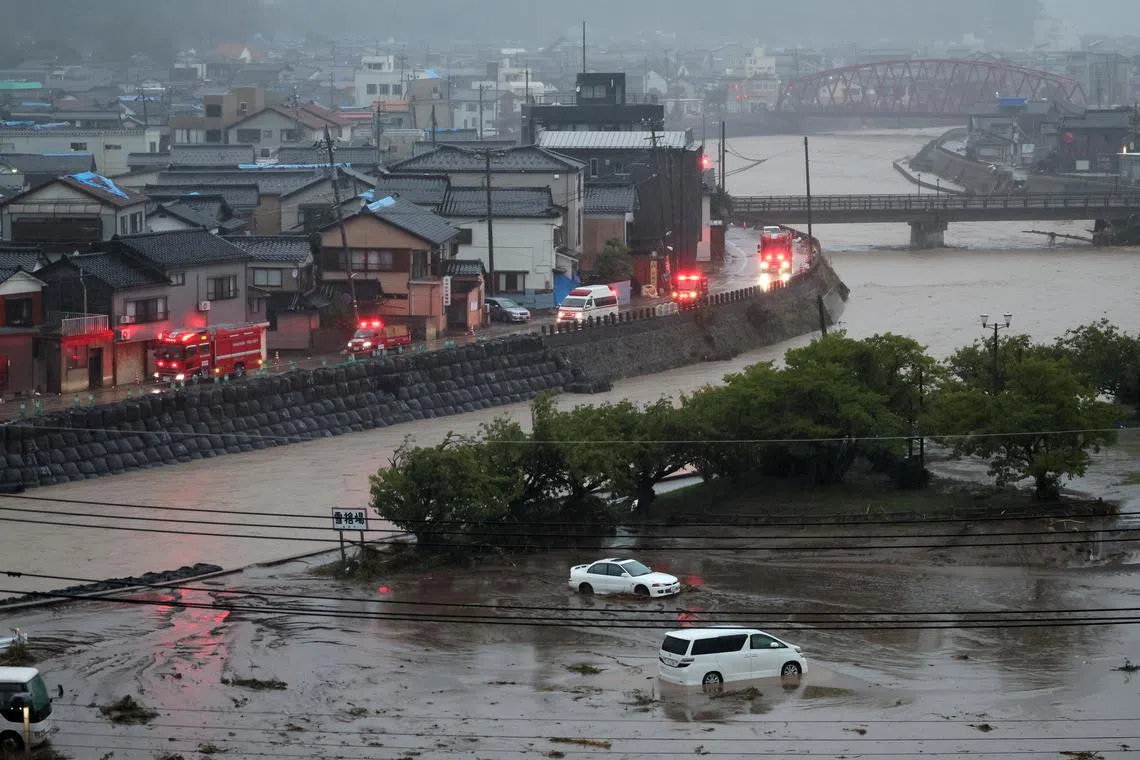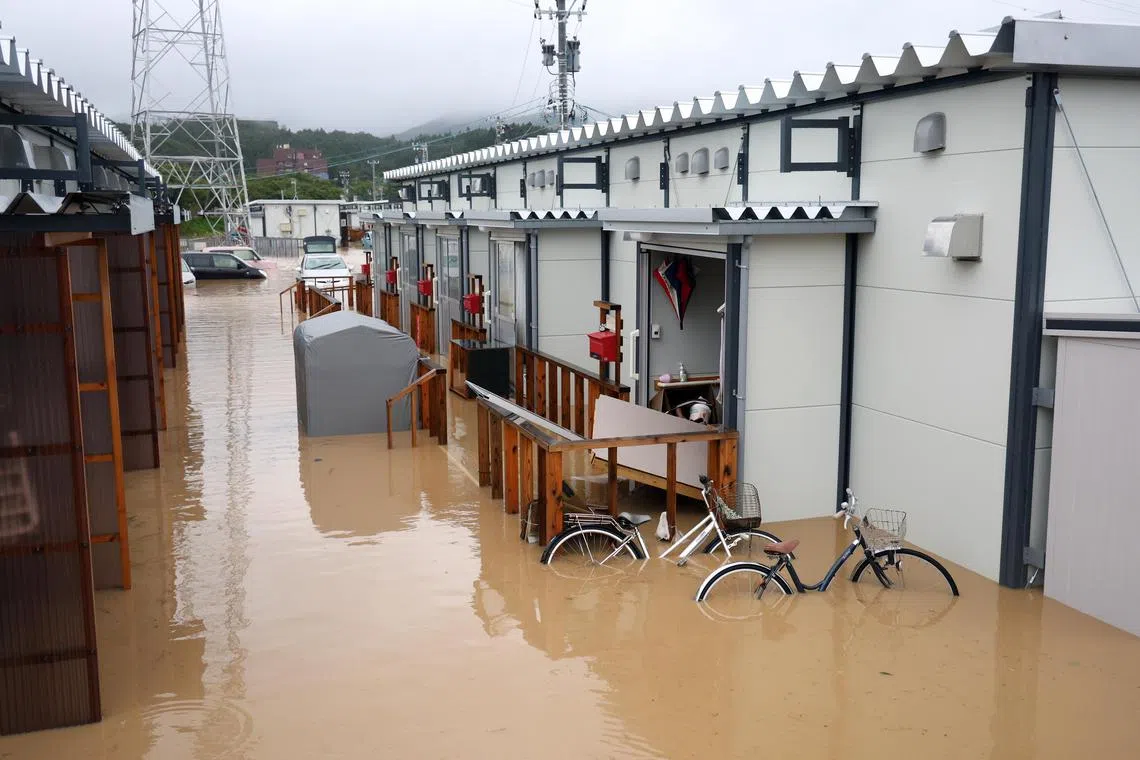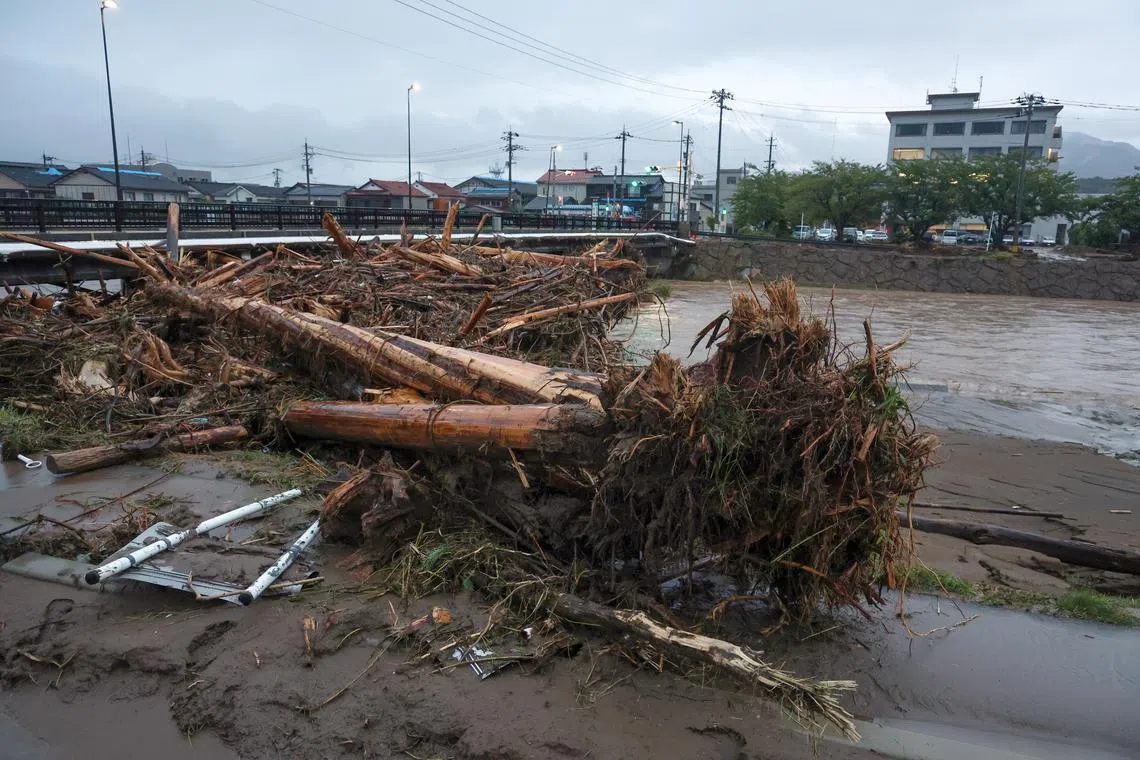Floods, landslides hit central Japan months after major quake
Sign up now: Get insights on Asia's fast-moving developments

A flooded parking area in Wajima, Japan, on Sept 22.
PHOTO: EPA-EFE
Follow topic:
ANAMIZU, Ishikawa - Floods and landslides killed one person and left at least 11 missing in central Japan, with recovery teams at work on Sept 22 in a remote peninsula already devastated by a major earthquake
“Unprecedented” heavy rain that lashed the area from Sept 21 began to subside, leaving muddy scenes of destruction as the national weather agency urged people to stay vigilant for loose ground and other dangers.
In the city of Wajima, splintered branches and a huge uprooted tree piled up at a bridge over a river whose raging brown waters almost reached ground level.
People were seen wading into the mud to try to dig out half-buried cars, while elsewhere, flood waters inundated emergency housing built for those who had lost their homes in the New Year’s Day earthquake that killed at least 318 people.
Ms Akemi Yamashita, a 54-year-old resident, told AFP that she was driving on Sept 21 when “within only 30 minutes or so, water gushed onto the street and quickly rose to half the height of my car”.
“I was talking to other residents of Wajima yesterday, and they said, ‘It is so heartbreaking to live in this city’. I got teary when I heard that,” she said, describing the earthquake and floods as “like something from a movie”.
Eight temporary housing complexes were affected in Wajima and Suzu – two of the cities on Noto Peninsula that were ravaged by the 7.5-magnitude quake, which toppled buildings, triggered tsunami waves and sparked a major fire.
More than 540mm of rain was recorded in Wajima in the 72 hours to the morning of Sept 22 – the heaviest continuous rain since comparative data became available in 1976.
Landslides blocked roads, complicating rescue efforts, and tens of thousands of people in the wider region were urged to evacuate.
Muddy rivers ran high in Anamizu, south of Wajima, where more rain fell on the morning of Sept 22 onto quake-damaged houses and the shattered stone columns of a shrine still lying on the ground months after they had been toppled.
A message blared from the city’s loudspeaker disaster prevention system, warning residents that the rain could flood the sewer system and dirty water could rise up.
Mr Hideaki Sato, 74, stood on a bridge, holding a small blue umbrella, anxiously looking at the swollen water of a small canal. “My house was flattened completely in the quake,” he told AFP.
“I now live in a small apartment room right there,” he said, pointing at a wooden structure behind him. “If this floods, it would be a real problem.”
‘Secure your safety’
Military personnel have been sent to the Ishikawa region on the Sea of Japan coast to join rescue workers, top government spokesman Yoshimasa Hayashi said on Sept 21.
Some 5,000 households were without power and at least 1,700 were without running water, the Ishikawa regional government said.
The Japan Meteorological Agency (JMA) downgraded its top warning to the second-highest alert on Sept 22.
The areas under the emergency warning saw “heavy rain of unprecedented levels”, JMA forecaster Satoshi Sugimoto said on Sept 21, adding “it is a situation in which you have to secure your safety immediately”.

Temporary housing units for people who had lost their homes in the New Year’s Day earthquake are flooded following heavy rainfall in Wajima, Japan, on Sept 22.
PHOTO: EPA-EFE
Scientists say human-driven climate change is intensifying the risk posed by heavy rain because a warmer atmosphere holds more water.
One person was killed
At least a dozen rivers burst their banks and two of the missing were reportedly carried away by strong currents.
Another three people who were missing had been working for the Land Ministry to restore a road in Wajima, local ministry official Yoshiyuki Tokuhashi told AFP.

Driftwood under a bridge in Wajima, Ishikawa Prefecture, on Sept 22.
PHOTO: EPA-EFE
Municipalities in Ishikawa told 110,000 residents in the region – including in the cities of Wajima and Suzu, as well as Noto town – to evacuate, officials said.
Another 17,300 residents in Niigata and Yamagata prefectures, north of Ishikawa, were also told to evacuate, the fire and disaster management agency said. AFP

